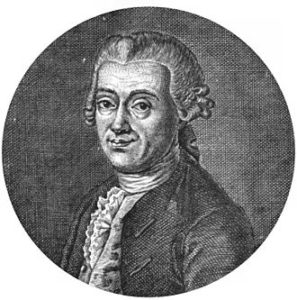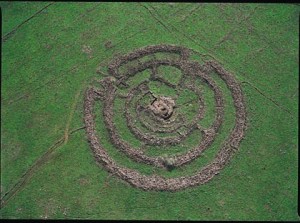Pythagoras
Bode’s Law
Bode’s Law or more correctly Titius-Bode’s Law is named after two German astronomers, Johann Daniel Titius and
Johann Elert Bode, proposed in the 18th century that there was a mathematical relationship between the then six known planets and their distance from the sun, with each one roughly twice the distance as the previous planet. Although the idea was conceived by Titius, it was Bode who gave it greater prominence, when he used it to predict the existence of Uranus and later Ceres in the Asteroid Belt. At that point, it was accepted as a ‘law’.
In the 19th century, Urbain LeVerrier and John Couch Adams working independently, used the Titius-Bode model combined with calculations based on Newton’s Law of Gravity to predict where the next planet, Neptune, should be found. Kamienski wrote a short paper comparing the formulae of LeVerrier & Adams with that of Titius-Bode(m).
The subject has been debated throughout the 20th century. I.J. Good, a British mathematician who worked with Alan Turing during WWII at Bletchley Park, offered a paper in support of Titius-Bode in 1968(b). Bradley Efron, an American statistician, proposed an opposing view(c). Both papers are best suited to the mathematically advanced.
The late Timo Niroma has offered some interesting observations(j) on the mechanics behind Titius-Bode and developed a cosmology based upon atomic weights, noting that “What happens on a small scale seems to obey the same laws on a much grander scale.”
Georgi Gladyshev, a Russian scientist, has proposed an explanation for Titius-Bode based on the work of Raphael Liesegang(g) who proposed the concept of ‘periodic precipitation’. Gladyshev applied Liesegang’s theory to the early stages of the formation of our Solar System(h)(i)(t)*. It was hoped that this may bring us closer to the physics behind the distribution of the planets!
It has also been proposed that a Titius-Bode-Type ‘rule’ seems to be applicable to planetary satellite systems(d), particularly that of Uranus(p), and there appears to be evidence(a) that Titius-Bode is also applicable to exoplanetary systems!
The Titius-Bode Law has also been linked with the Fibonacci Series(e) as well as the Golden Mean(f).
Velikovskian catastrophism proposes[0037.152] that Atlantis was destroyed as a result of the periodic close encounters of our planet and Moon with Venus and/or Mars during the 1st & 2nd millennia BC. According to Velikovsky, Venus was a relatively recent newcomer to the Solar System and the orbit of Mars had been disturbed, which would suggest that prior to the arrival of Venus and the displacement of Mars, Bode’s Law would have been invalidated! C.J. Ransom has tackled this head-on in The Age of Velikovsky [1880.90]. However, his defence of Bode and Velikovsky was rejected by Dr M. M. Nieto(n).
Louis Jacot (1906- ) was a Swiss economist and jurist who added the study of science and philosophy to his intellectual toolkit. He developed some novel cosmological theories, including enthusiastic support for Bode’s Law which he described as “the great key to the mysteries of the Universe.” [1774] While this may be overstating his case, I cannot help feeling that Bode’s Law is an expression of cosmological principles operating in a manner not as yet identified! At its simplest, the question is, are we to believe that the spacing of the planets came about purely by chance or is there an unrecognised force or forces at play?
For my own part, I have always felt that Bode’s Law was a highly convincing concept, but unfortunately, I do not have the mathematical or astronomical ability required to objectively verify its reality, nor the proposed Fibonacci Sequence and the Golden Mean relationship with it. It would appear that acceptance of Bode would create difficulties not just for the Saturn Theory but also for Velikovsky’s idea that Venus was just a large piece of ejecta from Jupiter that had catastrophic close encounters with Earth and Mars, within human experience, just a few thousand years ago. Such an idea would mean that prior to the Saturnian rearrangement of the planets or the Velikovskian creation of Venus, the positional relationship of the planets probably did not conform to any known mathematical model but after this/these calamitous events everything ‘coincidentally’ settled into orbits that are now claimed to conform to Bode, Fibonacci and the Golden Mean! Can we believe that after careening around the solar system including a number of close encounters with Earth, that all the planets adopted new orbits that conformed closely with Bode’s Law? Surely, this is a coincidence too far?
Stephen M. Phillips has published a lengthy paper entitled ‘The Logarithmic Spiral Basis of the Titius-Bode Law’. For me this document is difficult to absorb, involving as it does Musical theory, Pythagoras, String Theory and plenty of mathematics (q).
Although the ‘Law’ has been generally abandoned by mainstream scientists, there is still interest in some quarters. One of those was the British astronomer, the late Michael Ovenden (1926-1987) who produced a modified version of the original formula(k). Another version involves an interpretation of quantum mechanics, called pilot-wave theory(l)!
W.I. Newman, M.P. Haynes, and Y. Terzian “have considered the psychological tendency to find a pattern where none exists, and have also discussed how inappropriate inferences regarding astronomical phenomena have been drawn from statistical analyses.” (o)
In May 2023, the Live Science website(r) wrote that “Earth probably shouldn’t exist – that’s because the orbits of the inner solar system planets — Mercury, Venus, Earth and Mars — are chaotic, and models have suggested that these inner planets should have crashed into each other by now. And yet, that hasn’t happened.”
Jacques Laskar, astronomer and research director at the National Center for Scientific Research and Paris Observatory is a co-author of the new study(s). in which he and his colleagues have identified for the first time ‘symmetries’ or ‘conserved quantities’ in the gravitational interactions that create a “practical barrier in the chaotic wandering of the planets,” Where previously they had calculated that there was a 1% possibility of collision among the inner planets over 5 billion years. However, the introduction of these new ‘symmetries’ suggested that it could take 30 billion years for any planets to collide.
I can’t help wondering if Bode’s Law might be an expression of these symmetries.
>Nearly a decade ago Doug Yurchey (writing as Tray Caladan) published a paper(u) in support of Bode’s Law. He brought Pluto back into the family of Solar System planets and suggested that more may be added – “Is Sedna the furthest extent of our planetary system? Doubtful. We may have to carry Bode’s Law out one, two or even three more places (distances) to arrive at the actual composition of our Solar System.”<
Also See: Saturn Theory
(a) https://arxiv.org/abs/1602.02877
(d) Titius-Bode-Type Rules for Planetary Satellite Systems (archive.org)
(f) https://www.fq.math.ca/Scanned/22-1/lombardi.pdf
(g) https://www.insilico.hu/liesegang/history/history.html
(h) As Above So Below – Georgi Gladyshev | MalagaBay (archive.org)
(i) https://file.scirp.org/pdf/NS_2015051816303613.pdf
(j) As Above So Below – Timo Niroma | MalagaBay (archive.org)
(k) https://www.researchgate.net/scientific-contributions/2021145656_Michael_W_Ovenden
(m) Atlantis, Volume 13, No.1 December 1959
(n) The Titius-Bode Law (archive.org)
(o) Redshift Data and Statistical Inference, Astrophys. J., 431, 147, 1994.
(p) https://old.world-mysteries.com/sci_8.htm 2/3rds of the way down
(q) http://www.smphillips.mysite.com/article-17.html
(r) Scientists discover secret ‘symmetries’ that protect Earth from the chaos of space | Live Science
(s) XY10707_min.pdf (pardot.com)
(t) (99+) The solar system evolution | Georgi Gladyshev – Academia.edu *
Pythagoras
Pythagoras (c570 – c495 BC) was a Greek philosopher and mathematician and probably best known today for the theorm relating to right-angled triangles that is named after him. However, it has been shown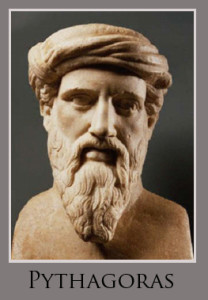 that it was known at least a thousand years earlier in Egypt, Babylon and China(a).
that it was known at least a thousand years earlier in Egypt, Babylon and China(a).
>In 2021 Dr Daniel Mansfield, a mathematician at the University of New South Wales discovered that a 3,700-year-old Babylonian clay tablet illustrates the use of what we call ‘Pythagorean triples’ in dividing land, 1,100 years before Pythagoras!(g)<
Although born in Samos he eventually moved to Croton in Magna Graecia, now southern Italy. There, he established a quasi-religious sect of what were in effect were number worshippers.
Wikipedia notes(c) that “Aristotle claimed that the philosophy of Plato closely followed the teachings of the Pythagoreans, and Cicero repeats this claim: Platonem ferunt didicisse Pythagorea omnia (“They say Plato learned all things Pythagorean”). Bertrand Russell, in his A History of Western Philosophy, contended that the influence of Pythagoras on Plato and others was so great that he should be considered the most influential of all Western philosophers.”
Mark Adams in his Meet Me in Atlantis[1070] has touched on the possible Pythagorean influence on Plato’s use of numbers in his Dialogues. With this in mind, Adams visited the late Ernest G. McClain the author of a highly original idea, namely that details contained in Plato’s Atlantis story can be explained in terms of mathematical/musical theory. This was expressed in his 1978 book, The Pythagorean Plato[1082], which can be read online(b), but, be warned, most will find this very technical offering rather heavy going.
In 2010, Dr. Jay Kennedy, an American at the University of Manchester, also claimed to have found evidence of Pythagorean influence in Plato’s dialogues claiming that they contain a regular mathematical structure which relates them to an ancient 12-note musical scale. “Kennedy’s breakthrough, published in the journal Apeiron this week, is based on stichometry: the measure of ancient texts by standard line lengths. Kennedy used a computer to restore the most accurate contemporary versions of Plato’s manuscripts to their original form, which would consist of lines of 35 characters, with no spaces or punctuation. What he found was that within a margin of error of just one or two percent, many of Plato’s dialogues had line lengths based on round multiples of twelve hundred.”(e) A critique(f) of Kennedy’s theory by Professor Andrew Gregory of University College London should be read for balance.
An example of Plato’s regard for specific numbers is his idea that 5,040 is a perfect number and is the ideal population for a polis (city). It is a number divisible by all integers from 1 to 10, which would have had even greater significance prior to the invention of decimals. Some of the other factoids claimed for this number are really scary or at least thought-provoking(d).
(a) https://www.storyofmathematics.com/greek_pythagoras.html
>(b) Wayback Machine (archive.org)<
(c) https://en.wikipedia.org/wiki/Plato#Plato_and_Pythagoras
(d) https://joedubs.com/5040-the-perfect-number/
(e) https://www.theguardian.com/world/2010/jun/29/plato-mathematical-musical-code
(f) https://discovery.ucl.ac.uk/1359825/1/Andrew%20Gregory.pdf
Adams, Mark
Mark Adams is an American writer from New York State with the best-selling Turn Right at Machu Picchu[976] to his credit. He  has spent recent years researching the subject of Atlantis, travelling extensively in the process. One of his trips took him to Ireland where I had the pleasure of meeting him and having many discussions on the subject.
has spent recent years researching the subject of Atlantis, travelling extensively in the process. One of his trips took him to Ireland where I had the pleasure of meeting him and having many discussions on the subject.
His book, Meet me in Atlantis[1070], gives readers an up-to-date overview of modern Atlantis theories that is both comprehensive and fair. I am aware of the amount of research that Adams has put into this work, interviewing a wide range of individuals, including myself, on both sides of the Atlantic. He has an easy-to-read style and while I do not agree with all of his views, I sincerely believe that this book should be compulsory reading for anyone with a serious interest in the subject.
Following the initial publication of his book Adams gave a number of promotional media interviews and in May 2016, following the publication of the paperback edition, he wrote an article(a) listing three ‘problems’ that he believes should be kept in mind when embarking on a search for Atlantis;
“1. Every Single Reliable Clue We Have about Atlantis comes from Plato
2.Plato Was a Pythagorean
3. Plato Was a Philosopher, not a Historian”
For my part, I do not see these as problems, just matters for consideration rather than concern.
*In Adam’s book, he refers to Stavros Papamarinopoulos as “the world’s most respected Atlantologist” [p.191] However, it is interesting to compare Adams’ problems with the comments of Papamarinopoulos in a paper delivered to the 2005 Atlantis Conference in which notes that critics of Plato’s Atlantis “carefully neglect to mention that only Plato and not the historians mention the following:
1.The Achaean Athens of the 12th century BC described in detail in Critias,
2.The end of the Achaean world in the 12th century BC,
3. The assault of the Sea Peoples in East Mediterranean in the 12th century BC,
4. The position of the giant westerly continent and
5. ‘Atlantis’,
All these have been proved except the fifth. Plato was not aware of the 12th century BC turmoil but he described its events in general terms correctly.” [629.555]
Although I do not subscribe to No. 4, as you can see in the America entry, Adams’ view of Plato as a historian is contradicted by the highly regarded Papamarinopoulos.
>Jason Colavito, not unexpectedly, has offered a review of Adam’s book(b).<
(b) Review of “Meet Me in Atlantis” by Mark Adams – Jason Colavito (archive.org) *
Geodesy
Geodesy is usually defined as the measurement and mapping of the Earth. James R. Smith, the author of Introduction to Geodesy [1947] has conflated several definitions to produce “Geodesy, from the Greek, literally means dividing the earth, and as a first objective, the practice of geodesy should provide an accurate framework for the control of national topographical surveys. Thus geodesy is the science that determines the figure of the earth and the interrelation of selected points on its surface by either direct or indirect techniques. These characteristics further make it a branch of applied mathematics, one that must include observations that can be used to determine the size and shape of the earth and the definition of coordinate systems for threedimensional positioning; the variation of phenomena near to or on the surface, such as gravity, tides, earth rotation, crustal movement, and deflection of the plumb line; together with units of measurement and methods of representing the curved earth surface on a flat sheet of paper.”
Geodesy as a science can be traced back to Pythagoras (6th cent. BC), who was thought to be the first to propose the sphericity of the Earth. Aristotle & Archimedes were apparently the first the offer a figure for the diameter of the Earth, suggesting 400,000 and 300,000 stades respectively. The difference might be partly explained by the use of a different length of stade.
Later, Eratosthenes (276 BC– 195 BC) offered another early attempt to determine the dimensions of our Earth and succeeded with remarkable accuracy.
A controversial aspect of modern geodesy is the claim that many ancient sites were deliberately established at locations that had a specific geodetic relationship to each other and/or the dimensions of the Earth. For example(a) in ancient Egypt, the distance from Giza to the Equator was calculated to be 1/12th the circumference of the Earth, Amarna to the Equator is 1/13th, Luxor 1/14th and Philae 1/15th!
Graham Hancock in his Heaven’s Mirror[855] pointed to similar relationships around the globe suggesting a possible world grid. This idea of a world grid has a number of supporters but is often classified as a ‘fringe’ interest due to the attempt by some to link gridlines with UFOs and their use of the grid as a power source(w).>Hancock’s various claims regarding the dimensions of the pyramids and their association with a suggested world grid has been challenged in great detail by a Hall of Maat article by Thomas W. Schroeder(ah), concluded that “Graham Hancock’s assertion that the Great Pyramid’s dimensions reveal knowledge of earth’s dimensions certainly lacks proof but also fails to hold up to any scrutiny as a viable theory. Each step argued by Hancock; that the Great Pyramid was built to a specific scalar, that the value of the scalar can be definitively demonstrated, that the scalar indicates precession, that the only way ancient Egyptians could estimate precession is to leverage or borrow knowledge from earlier advanced and unrecognized civilizations, are each filled with flaws when taken individually, let alone when strung together to complete his narrative.”<
Possibly related features may be the ley lines identified by Alfred Watkins in Britain(c)(g), the Alesia alignments in France discovered by Xavier Guichard(b) and/or the Heilige Linien of Germany claimed by Wilhelm Teudt(aa).
Heinz Kaminski claimed to have discovered a megalithic grid system that stretched from Stonehenge across Europe with an east-west and north-south orientation and referred to as the Stonehenge/Wormbach System(h).
Even more exotic is the ancient Raetiastone navigation system rediscovered by Gerhard Pirchl (1942-2013) and outlined in a book by [1831] Thomas Walli(ae).
Ashley Cowie has published a paper(ac) related to Alesia and the work of Guichard and others, as well as his own investigations.
I should also point out that Marcel Mestdagh also identified a form of a road system, laid out in giant ovals with radials in France. At the centre of these ovals was the ancient city of Sens. Philip Coppens informs us [1275.184] that a further strange discovery by Mestdagh was that this ancient road network, centred on Sens, was mirrored by a similar network of roads in England centred on Nottingham!
‘The Way of Virachoca’ in the Andes which runs through Tiwanaku and is oriented exactly 45° west of true north and runs for over 1000 miles, has been studied by Maria Scholten d’Ebneth [1236] in the 1970s and expanded on by a number of Spanish speaking commentators and is now the subject of an article by Dave Truman(x).
In 1973, three Russians, engineers Valery Makarov and Vyacheslav Morozov along with Nikolay Goncharov, an artist, published in Russian an article with the eye-catching title of Is the Earth a Giant Crystal? (y) This was probably the earliest presentation of an earth grid based on ancient historical sites. A brief history of the earth grid theories that emerged around this time is available online(z). There is now a Russian geodesy website with an English translation(ab).
David Hatcher Childress published his Anti-Gravity and the World Grid [1303] in 1993, with the modest claim that he “proves that the earth is surrounded by an intricate electronic grid network offering free energy.” Obviously, Childress’ understanding of ‘proof’ is different to mine, as the only proof required is the production of some of this free energy, which he has not done.
Tom Brooks entered the fray with a study of 1500 prehistoric sites and his conclusion that the inhabitants of ancient Britain had designed a navigation system based on a grid of isosceles triangles(i). Brooks has gone a step further and speculatively claimed that the accuracy of this geometry-based system could only have been designed through “extraterrestrial intervention”(r). This concept is explored more fully in his latest book, Seeing Around Corners: Geometry in Stone Age Britain [863] and in a series of video clips(s). A more critical view of Brooks’ ideas is also available on the Internet(j).
Some years ago a former employee of a NASA sub-contractor, Maurice Chatelain claimed that within a 450-mile radius of the Aegean island of Delos that 13 mystical sites, when connected by straight lines formed a perfect Maltese Cross(u)!
Others such as Livio Stecchini(d) and Jim Alison(e) using geodetic calculations have identified São Tomé and Cape Verde respectively as the location of Atlantis. I must also include Hugo Kennes, a Belgian researcher with a passionate interest in global grids and sacred geometry(l). Kennes has also informed me of a new Facebook group(q) dealing with all aspects of the subject, as well as another(v) that includes submerged cities and other features.
Anyone interested in pursuing a study of this subject might like to look over James Q. Jacobs’ archaeogeodesy website(f) as well as the BioGeometry website (m).
If you have pursued all the links so far, you can pamper yourself further with a paper(k) by William Becker and Beth Hagens(n). Another researcher in this field is Dan Shaw whose website(o) gives a good overview of the subject.
Jean-Pierre Lacroix added his weight to the debate with his 1998 paper entitled The Mapmakers from the Ice Age(t).
A global network of sacred sites was also put forward by Rand Flem-Ath & Colin Wilson in The Atlantis Blueprint [063]. This book was intended as a sequel to When the Sky Fell [062], but generally wandered off into other areas after the first couple of chapters.
I am somewhat sceptical about certain aspects of geodesy, particularly some of the claims of a world grid. However, it does raise many questions that require further study and explanation. In this connection, I would recommend John Sase’s Curious Alignments [1589] as a good starting point. He confirms the work of Guichard and also offers a range of his own discoveries in the Great Lakes region.
In February 2020, Frank Maglione Nicholson, Ken Phungrasamee & David Grimason, collectively known as The Nazca Group(ad), published The Nazca Great Circle Map Hypothesis. Their claim is that “The lines and geoglyphs carved into the Nazca plateau represent a map of the Earth. The map is a Great Circle Map: a gnomonic projection with the center of the Earth as its cartographic viewpoint. Each line on the Nazca Plateau represents a great circle of navigation centred at the centre of the Earth and encircling the entire planet. The majority of the lines on the Nazca Plateau radiate from five loci of origin called radial centres.” I found this rather esoteric proposition difficult to absorb.
Arturo Villamarin has published many books [1864] and papers(af)(ag) in which the geometry and astronomy of archaeological monuments; Göbekli Tepe, Stonehenge, Teotihuacán and Mohenjo Daro, among others, are discussed.
(a) http://www.ancient-wisdom.com/geodesy.htm
(b) http://www.ancient-wisdom.com/xavierguichard.htm
(c) http://www.ancient-wisdom.com/leylines.htm
(d) http://www.metrum.org/mapping/atlantis.htm (link broken Dec. 2020)
(e) http://home.hiwaay.net/~jalison/concl.html
(f) https://web.archive.org/web/20200917015056/http://www.jqjacobs.net/index.html
(g)https://liminalthresholds.blogspot.ie/2008/04/earth-energy-ley-lines.html
(i) See: https://web.archive.org/web/20160628154229/https://www.prehistoric-geometry.co.uk/
(j) https://www.badscience.net/2010/01/voices-of-the-ancients/
(k) https://www.bibliotecapleyades.net/ciencia/antigravityworldgrid/ciencia_antigravityworldgrid02.htm
(m) https://web.archive.org/web/20170328094319/https://www.biogeometry.org/page34.html
(n) Bethe Hagens – Geometry, Anthropology anf the Arts of Consciousness (archive.org)
(o) https://www.vortexmaps.com/grid-history.php
(q) https://www.facebook.com/groups/175027289350368/
(r) https://www.prehistoric-geometry.co.uk/ [See (i)]
(s) https://www.youtube.com/watch?v=R35A80kV0AU&feature=relmfu
(t) https://ancientcartography.net/geoAN.html
(u) https://www.mail-archive.com/ctrl@listserv.aol.com/msg28306.html
(v) https://www.facebook.com/groups/493298404177687/
(w) https://predictionsmargiekay.blogspot.ie/2014/08/lines-of-latitude-and-ufoparanormal-hot.html
(x) https://grahamhancock.com/trumand1/
(y) https://atlantipedia.ie/samples/archive-3193/
(z) https://www.vortexmaps.com/grid-history.php
(aa) https://www.cantab.net/users/michael.behrend/repubs/teudt_hl/pages/index.html
(ac) Solstice Axis Of The Ancient Gauls — ASHLEY COWIE (archive.org)
(ad) The Nazca Solution – The final solution to what the Nazca Lines represent (archive.org)
(ae) https://www.megalithic.co.uk/article.php?sid=2146413597
(ag) (99+) (PDF) THE GEOMETRY AND ASTRONOMY OF GOBEKLI TEPE | Arturo Villamarin – Academia.edu
Concentric Rings *
The Concentric Rings or other architectural features extracted by artists from Plato’s description of the capital of Atlantis have 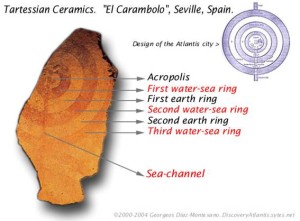 continually fascinated students of the story and many have attempted to link them with similar ancient features found elsewhere in the world as evidence of a widespread culture. Stonehenge, Old Owstrey, Carthage and Syracuse have all been suggested, but such comparisons have never been convincing. Diaz-Montexano has recently published(a) an image of a fragment of pottery found near Seville in Spain that shows concentric circles and insists that it is a symbol of Atlantis. Ulf Erlingsson has made a similar claim regarding some concentric circles carved on a stone basin found at Newgrange in Ireland.
continually fascinated students of the story and many have attempted to link them with similar ancient features found elsewhere in the world as evidence of a widespread culture. Stonehenge, Old Owstrey, Carthage and Syracuse have all been suggested, but such comparisons have never been convincing. Diaz-Montexano has recently published(a) an image of a fragment of pottery found near Seville in Spain that shows concentric circles and insists that it is a symbol of Atlantis. Ulf Erlingsson has made a similar claim regarding some concentric circles carved on a stone basin found at Newgrange in Ireland.
Less well-known are the concentric stone circles that are to be found on the island of Lampedusa in the Strait of Sicily(b).
In 1969 two commercial pilots, Robert Brush and Trigg Adams photographed a series of large concentric circles in about three feet of water off the coast of Andros in the Bahamas. Estimates of the diameter of the circles range from 100 to 1,000 feet. Apparently, these rings are now covered by sand. It is hard to understand how such a feature in such very shallow water cannot be physically located and inspected. Richard Wingate in his book [0059] estimated the diameter at 1,000 yards. However, the rings described by Wingate were apparently on land, among Andros’ many swamps.
A recent (2023) report has drawn attention to the ancient rock art found on Kenya’s Mfangano Island where a number of concentric circles estimated as 4,000 years old can be seen(q).
Two papers presented to the 2005 Atlantis Conference on Melos describe how an asteroid impact could produce similar concentric rings, which, if located close to a coast, could be converted easily to a series of canals for seagoing vessels. The authors, Filippos Tsikalas, V.V. Shuvavlov and Stavros Papamarinopoulos gave examples of such multi-ringed concentric morphology resulting from asteroid impacts. Not only does their suggestion provide a rational explanation for the shape of the canals but would also explain the apparent over-engineering of those waterways.
At the same conference, the late Ulf Richter presented his idea [629.451], which included the suggestion that the concentric rings around the centre of the Atlantis capital had a natural origin. Richter has proposed that the Atlantis rings were the result of the erosion of an elevated salt dome that had exposed alternating rings of hard and soft rock that could be adapted to provide the waterways described by Plato.
Georgeos Diaz-Montexano has suggested that the ancient city under modern Jaen in Andalusia, Spain had a concentric layout similar to Plato’s description of Atlantis. In August 2016 archaeologists from the University of Tübingen revealed the discovery(i) of a Copper Age, Bell Beaker People site 50km east of Valencina near Seville, where the complex included a series of concentric earthwork circles.
A very impressive example of man-made concentric stone circles, known in Arabic as Rujm el-Hiri and in Hebrew as Gilgal Refaim(a), is to be found on the Golan Heights, now part of Israeli-occupied Syria. It consists of four concentric walls with an outer diameter of 160metres. It has been dated to 3000-2700 BC and is reputed to have been built by giants! Mercifully, nobody has claimed any connection with Atlantis. That is until 2018 when Ryan Pitterson made just such a claim in his book, Judgement of the Nephilim[1620].
Jim Allen in his latest book, Atlantis and the Persian Empire[877], devotes a well-illustrated chapter to a discussion of a number of ‘circular cities’ that existed in ancient Persia and which some commentators claim were the inspiration for Plato’s description of the city of Atlantis. These include the old city of Firuzabad which was divided into 20 sectors by radial spokes as well as Ecbatana and Susa, both noted by Herodotus to have had concentric walls. Understandably, Allen, who promotes the idea of Atlantis in the Andes, has pointed out that many sites on the Altiplano have hilltops surrounded by concentric walls. However, as he seems to realise that to definitively link any of these locations with Plato’s Atlantis a large dollop of speculation was required.
Rodney Castleden compared the layout of Syracuse in Sicily with Plato’s Atlantis noting that the main city “had seen a revolution in its defensive works, with the building of unparalleled lengths of circuit walls punctuated by numerous bastions and towers, displaying the city-state’s power and wealth. The three major districts of the city, Ortygia, Achradina and Tycha, were surrounded by three separate circuit walls; Ortygia itself had three concentric walls, a double wall around the edge and an inner citadel”.[225.179]
Dale Drinnon has an interesting article(d) on the ‘rondels’ of the central Danubian region, which number about 200. Some of these Neolithic features have a lot in common with Plato’s description of the port city of Atlantis. The ubiquity of circular archaeological structures at that time is now quite clear, but they do not demonstrate any relationship with Atlantis.
The late Marcello Cosci based his Atlantis location on his interpretation of aerial images of circular features on Sherbro Island, but as far as I can ascertain this idea has gained little traction.
One of the most remarkable natural examples of concentric features is to be found in modern Mauritania and is known as the Richat Structure or Guelb er Richat. It is such a striking example that it is not surprising that some researchers have tried to link it with Atlantis. Robert deMelo and Jose D.C. Hernandez(o) are two advocates along with George S. Alexander & Natalis Rosen who were struck by the similarity of the Richat feature with Plato’s description and decided to investigate on the ground. Instability in the region prevented this until late 2008 when they visited the site, gathering material for a movie. The film was then finalised and published on their then newly established website in 2010(l), where the one hour video in support of their thesis can be freely downloaded(m).
In 2008, George Sarantitis put forward the idea that the Richat Structure was the location of Atlantis, supporting his contention with an intensive reappraisal of the translation of Plato’s text(n). He developed this further in his Greek language 2010 book, The Apocalypse of a Myth[1470] with an English translation currently in preparation.
However, Ulf Richter has pointed out that Richat is too wide (35 km), too elevated (400metres) and too far from the sea (500 km) to be seriously considered as the location of Atlantis.
A dissertation by Oliver D.Smith has suggested(e) the ancient site of Sesklo in Greece as the location of Atlantis, citing its circularity as an important reason for the identification. However, there are no concentric walls, the site is too small and most importantly, it’s not submerged. Smith later decided that the Atlantis story was a fabrication!(p)
Brad Yoon has claimed that concentric circles are proof of the existence of Atlantis, an idea totally rejected by Jason Colavito(j).
In March 2015, the UK’s MailOnline published a generously illustrated article(g) concerning a number of sites with unexplained concentric circles in China’s Gobi Desert. The article also notes some 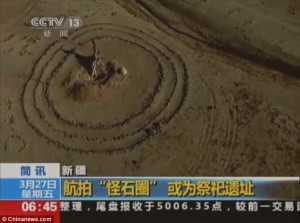 superficial similarities with Stonehenge. I will not be surprised if a member of the lunatic fringe concocts an Atlantis theory based on these images. (see right)
superficial similarities with Stonehenge. I will not be surprised if a member of the lunatic fringe concocts an Atlantis theory based on these images. (see right)
Paolo Marini has written Atlantide:Nel cerchio di Stonehenge la chiave dell’enigma (Atlantis: The Circle is the Key to the enigma of Stonehenge) [0713]. The subtitle refers to his contention that the concentric circles of Atlantis are reflected in the layout of Stonehenge!
In 2011 Shoji Yoshinori offered the suggestion that Stonehenge was a 1/24th scale model of Atlantis(f). He includes a fascinating image in the pdf.
This obsession with concentricity has now extended to the interpretation of ancient Scandinavian armoury in particular items such as the Herzsprung Shield(c).
For my part, I wish to question Plato’s description of the layout of Atlantis’ capital city with its vast and perfectly engineered concentric alternating bands of land and sea. This is highly improbable as the layout of cities is invariably determined by the natural topography of the land available to it(h). Plato is describing a city designed by and for a god and his wife and as such his audience would expect it to be perfect and Plato did not let them down. I am therefore suggesting that those passages have been concocted within the parameters of ‘artistic licence’ and should be treated as part of the mythological strand in the narrative, in the same way, that we view the ‘reality’ of Clieto’s five sets of male twins or even the physical existence of Poseidon himself.
Furthermore, Plato was a follower of Pythagoras, who taught that nothing exists without a centre, around which it revolves(k). A concept which may have inspired him to include it in his description of Poseidon’s Atlantis.
(b) Megalithic Lampedusa (archive.org)
(c) https://www.parzifal-ev.de/index.php?id=20
(d) See: Archive 3595
(e) https://atlantipedia.ie/samples/archive-3062/
(f) https://www.pipi.jp/~exa/kodai/kaimei/stonehenge_is_small_atrantis_eng.pdf
(i) First Bell Beaker earthwork enclosure found in Spain | ScienceDaily (archive.org) *
(j) https://www.jasoncolavito.com/blog/rings-of-power-do-concentric-circles-prove-atlantis-real
(k) Pythagoras and the Mystery of Numbers (archive.org)
(l) Visiting Atlantis | Gateway to a lost world (archive.org)
(m) https://web.archive.org/web/20171022134926/https://visitingatlantis.com/Movie.html
(n) https://platoproject.gr/system-wheels/ https://platoproject.gr/page13.html (offline Nov.2015)
(o) https://blog.world-mysteries.com/science/a-celestial-impact-and-atlantis/ (item 11)
(p) https://shimajournal.org/issues/v10n2/d.-Smith-Shima-v10n2.pdf
McClain, Ernest G.
 Ernest G. McClain (1918-2014) was a professor emeritus of music at Brooklyn College, New York. He is also the author of a highly original idea that details incorporated in Plato’s Atlantis story can be explained in terms of mathematical/musical theory(b), detailed in The Pythagorean Plato[1082].
Ernest G. McClain (1918-2014) was a professor emeritus of music at Brooklyn College, New York. He is also the author of a highly original idea that details incorporated in Plato’s Atlantis story can be explained in terms of mathematical/musical theory(b), detailed in The Pythagorean Plato[1082].
>McClain attributed the development of musical theory to the Sumerians of around 3000 BC(c).<
However, the application of McClain’s hypothesis is not confined to Plato but was extended to both the New Testament and the Indian Vedas. His work is fully expounded in his Myth of Invariance: The Origins of the Gods, Mathematics and Music from the Rig Veda to Plato[1284], published in 1985. However commendable, his work is highly technical and not for the faint-hearted. He also wrote an appendix for Driscoll & Kurtz’s Atlantis: Egyptian Genesis[0672].
Ernest McClain passed away on April 25th, 2014(a).
(a) https://www.legacy.com/obituaries/nytimes/obituary.aspx?n=ernest-glenn-mcclain&pid=170921414
Sonchis
Sonchis was the elderly Egyptian priest of Sais, who, according to Plutarch(a), related to Solon the story of Atlantis as recorded in their temple. These conversations took place around 590 BC. Additionally, Plutarch records that Solon also spoke with Psenophis a priest of Heliopolis.
Over four hundred years after Plutarch, Proclus named three priests that Solon had met in Egypt, Pateneit in Sais as well as Ochlapi at Heliopolis and Ethimon at Sebbynetus.
Lewis Spence notes that Clement of Alexandria also gave Sonchis as the name of the Egyptian priest who related to Pythagoras details of the science of the Egyptians.
Another name suggested by Paulo Riven is that of Udja-Hor-res-ne (Wedjahor-Resne) which might relate to another priest or an alternative name for Sonchis. This person was not only a priest and physician but also an admiral. A headless statue of Udja-Hor-res-ne is to be found in the Vatican Museum. I would urge caution regarding this identification.
(a) https://ancienthistory.about.com/library/bl/bl_text_plutarch_solon.htm
(b) https://grahamhancock.com/phorum/read.php?1,181064,181241#msg-181241

